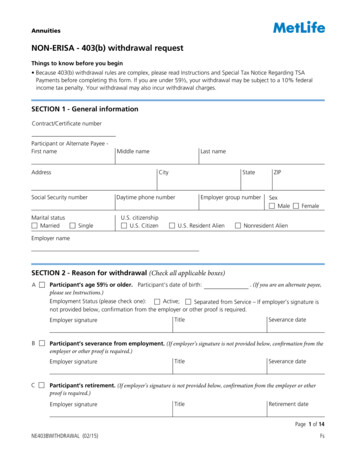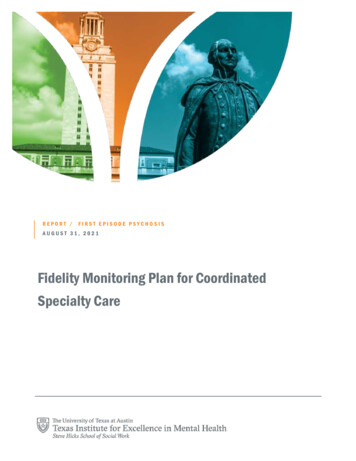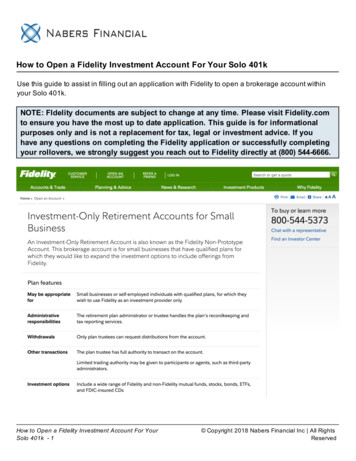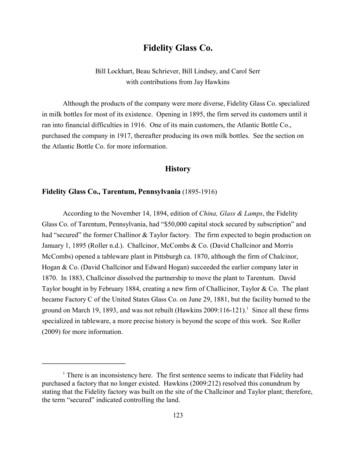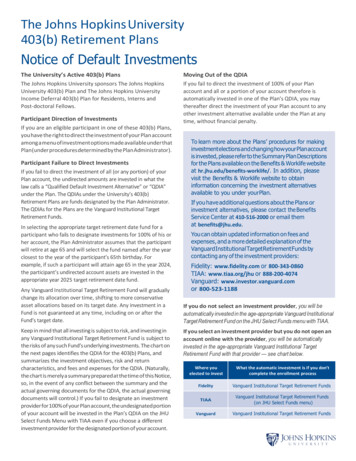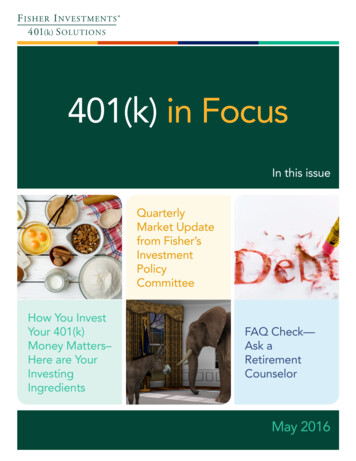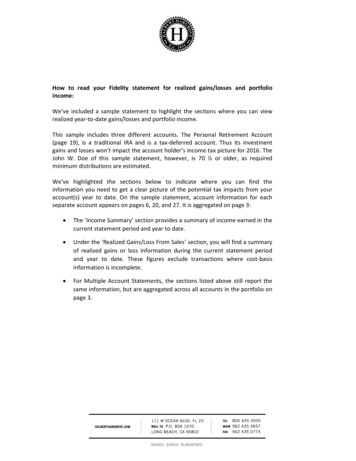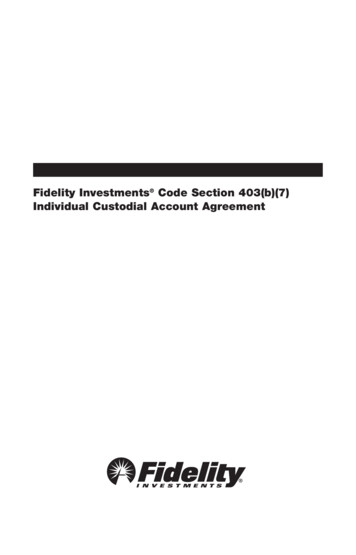
Transcription
Fidelity Investments Code Section 403(b)(7)Individual Custodial Account Agreement
18.19.20.21.Introduction . . . . . . . . . . . . . . . . . . . . . . . . . . . . . . . . . . . . . . . . . . . . . . . . . . . . . .Definitions . . . . . . . . . . . . . . . . . . . . . . . . . . . . . . . . . . . . . . . . . . . . . . . . . . . . . . .Individual Custodial Account . . . . . . . . . . . . . . . . . . . . . . . . . . . . . . . . . . . . . . . .Contributions . . . . . . . . . . . . . . . . . . . . . . . . . . . . . . . . . . . . . . . . . . . . . . . . . . . . .Investments . . . . . . . . . . . . . . . . . . . . . . . . . . . . . . . . . . . . . . . . . . . . . . . . . . . . . .Distributions . . . . . . . . . . . . . . . . . . . . . . . . . . . . . . . . . . . . . . . . . . . . . . . . . . . . .Rollovers and Transfers . . . . . . . . . . . . . . . . . . . . . . . . . . . . . . . . . . . . . . . . . . . .Minimum Required Distributions. . . . . . . . . . . . . . . . . . . . . . . . . . . . . . . . . . . . .Distributions: Miscellaneous Provisions . . . . . . . . . . . . . . . . . . . . . . . . . . . . . . .Loans . . . . . . . . . . . . . . . . . . . . . . . . . . . . . . . . . . . . . . . . . . . . . . . . . . . . . . . . . . .Rights and Duties of Custodian . . . . . . . . . . . . . . . . . . . . . . . . . . . . . . . . . . . . . .Directions and Indemnification . . . . . . . . . . . . . . . . . . . . . . . . . . . . . . . . . . . . . .Fees and Expenses. . . . . . . . . . . . . . . . . . . . . . . . . . . . . . . . . . . . . . . . . . . . . . . . .Resignation of Custodian . . . . . . . . . . . . . . . . . . . . . . . . . . . . . . . . . . . . . . . . . . .Duration . . . . . . . . . . . . . . . . . . . . . . . . . . . . . . . . . . . . . . . . . . . . . . . . . . . . . . . . .Amendments and Termination. . . . . . . . . . . . . . . . . . . . . . . . . . . . . . . . . . . . . . .Status of the 403(b) Plan . . . . . . . . . . . . . . . . . . . . . . . . . . . . . . . . . . . . . . . . . . .Personal Data. . . . . . . . . . . . . . . . . . . . . . . . . . . . . . . . . . . . . . . . . . . . . . . . . . . . .Privacy . . . . . . . . . . . . . . . . . . . . . . . . . . . . . . . . . . . . . . . . . . . . . . . . . . . . . . . . . .Conversion to a Group Custodial Account . . . . . . . . . . . . . . . . . . . . . . . . . . . . .Additional Provisions . . . . . . . . . . . . . . . . . . . . . . . . . . . . . . . . . . . . . . . . . . . . . .1145912141618181920212122222323242425
Fidelity Investments Code Section 403(b)(7)Individual Custodial Account Agreement1.IntroductionThis Agreement sets forth the terms of the Individual Custodial Account establishedby the Custodian on behalf of the Participant, which is intended to constitute acontract that satisfies the requirements of Internal Revenue Code Section 403(b)(7)and §1.403(b)-3. The terms of this Agreement shall be effective as of January 1, 2008,and this Agreement shall amend and supersede the 2004 Agreement or any prioragreement. This Agreement shall govern all 403(b) Accounts established under the2004 Agreement (or any other superseded Fidelity Investments Section 403(b)Individual Custodial Account Agreement) and all 403(b) Accounts established on andafter January 1, 2008.2.DefinitionsThe following terms used in this Agreement have the meaning indicated, unless thecontext clearly requires otherwise:“Account” means the account established under this Agreement to hold theParticipant’s or Beneficiary’s accumulated benefits under the Plan and for such otherpurposes as may be required from time to time.“Agreement” means this Fidelity Investments Code Section 403(b)(7) IndividualCustodial Account Agreement, as it may be amended and in effect from time to time.“2004 Agreement” means the Fidelity Investments Section 403(b)(7) IndividualCustodial Account Agreement, generally effective as of April 1, 2004, and assubsequently amended by FMR Corp., the predecessor to FMR LLC. The 2004Agreement has been amended and restated in full, as set forth herein, as permittedby Section 13 of the 2004 Agreement. FMR LLC has also delegated to the Custodianall future rights to amend, restate, and/or terminate this Agreement.“Approved Vendor” means a Vendor that has been designated by the Employerto the Custodian and Fidelity Affiliates as approved to receive contributions andexchanges under the Plan, as further described in Section 5(c) of this Agreement.“Authorized Agent” means a person or entity designated in an authorization In GoodOrder that is submitted to the Custodian by the Participant (and approved by theEmployer, if required) or the Employer to access such Participant’s Account, direct theinvestment of assets held, deposited, transferred, exchanged, or otherwise contributedto such Account, request the deduction of fees from such Account, and/or performother specified functions. Authorized Agents may include, but are not limited to, theEmployer, Fiduciary Advisors, investment managers, and entities acting under a powerof attorney on behalf of the Participant, whether individuals or entities. The rights ofAuthorized Agents may be further described in the Recordkeeping Arrangement (RKA)or other directions from the Employer or Participant to the Custodian.“Beneficiary” means, subject to the terms of the Plan, the designated beneficiary orbeneficiaries of the Participant after his or her death, until the Beneficiary’s accounthas been fully distributed. The term Beneficiary shall also include the alternatepayee(s) of the Participant named in a qualified domestic relations order (QDRO) asdefined in Code Section 414(p) and, if applicable, ERISA Section 206(d), if consistentwith the order. The rights of Beneficiaries are set forth in the Plan, and the processes1
and procedures for designating Beneficiaries and establishing Beneficiary accountsare documented in the RKA, Section 6(f) of this Agreement and/or Beneficiarydesignation forms.“Code” means the Internal Revenue Code of 1986, as amended from time to time.All “§” references in this Agreement are to the Treasury Regulations issued underTitle 26 of the Code of Federal Regulations, as amended from time to time.“Custodian” means Fidelity Management Trust Company, a Massachusetts trustcompany, and any successor to all or substantially all of its trust, banking, andcustodial businesses that satisfies the conditions in Code Section 401(f)(2), providedthat such custodian is a Fidelity Affiliate.“Eligible Employee” means an employee, as defined in §1.403(b)-2(b)(9), of theEmployer who meets the requirements for participation under the Plan.“Eligible Employer” means an employer as defined in §1.403(b)-2(b)(8).“Eligible Retirement Plan” has the meaning set forth in Code Section 402(c)(8)(B).“Eligible Rollover Distribution” has the meaning set forth in Code Section 402(c)and §1.402(c)-2. Other distribution amounts may be excluded from the definition ofEligible Rollover Distribution, as required by the Code and the regulations thereunder.“Employer” means the entity that assumes the responsibility of the Employer withrespect to the Plan. If the Employer is a nongovernmental tax-exempt entity, the term“Employer” shall include any other entities that are aggregated with the Employerunder the controlled group rules of Code Section 414(c), consistent with the terms ofthe Plan. For purposes of this Agreement, the term Employer shall refer to the entityitself, and/or any administrator, named fiduciary, or committee properly designatedby the Employer to carry out its duties and responsibilities hereunder. If there is noEmployer associated with this Account, the Employer cannot be located, theEmployer is no longer an Eligible Employer, or in other similar situations, theCustodian shall follow applicable Code and ERISA guidance in determining its propernondiscretionary treatment and/or disposition of the Account.“ERISA” means the Employee Retirement Income Security Act of 1974, as amendedfrom time to time.“Fidelity Affiliate” means any entity that, directly or indirectly, through one or moreintermediaries, controls, is controlled by, or is under common control with FMR LLC.“Fidelity Mutual Fund” means any regulated investment company (as defined inCode Section 851(a) relating to mutual funds) advised by Fidelity Management &Research Company or any of its affiliates.“Fiduciary Advisor” means a person or entity that is a fiduciary of the Plan byreason of providing investment advice and that is a registered investment advisor,a bank or similar financial institution, an insurance company, or a registeredbroker-dealer; an “affiliate” of such registered investment adviser, bank, insurancecompany, or broker-dealer; or an employee, agent, or registered representative of anysuch entity (as defined in ERISA Sections 408(g)(11)(A) and (B) if the Plan is subjectto ERISA). A Fidelity Affiliate may undertake fiduciary responsibility with respect tothe Account and/or Plan as a Fiduciary Advisor and/or investment manager pursuantto a separate written agreement with the Employer and/or Participant, as appropriate.“Group Custodial Account” or “GCA” means the custodial account, which may beestablished and maintained by the Employer and the Custodian to hold the assets ofthe Plan with respect to one or more Participants.2
“Individual Custodial Account” or “ICA” means the Fidelity Investments CodeSection 403(b)(7) Individual Custodial Account established by the Participant andmaintained as the Participant’s Account pursuant to this Agreement, as amendedand in effect from time to time.“In Good Order” means in a state or condition acceptable to the Custodian andFidelity Affiliates in their sole discretion and determined to be reasonably necessaryfor the accurate execution of the intended transaction or direction.“Losses” means any and all loss, damage, penalty, liability, cost, and expense,including, without limitation, reasonable attorneys’ fees.“Mutual Funds” means both Fidelity Mutual Funds and Non-Fidelity Mutual Funds.“Non-Fidelity Mutual Fund” means any regulated investment company (as defined inCode Section 851(a) relating to mutual funds) not advised by Fidelity Management &Research Company or any of its affiliates.“Participant” means the employee, former employee, or Beneficiary holding assetsin this Account who has not yet received a distribution of the entire accumulatedbenefit in the Account. For purposes of this Agreement, the term “Participant” shallalso include the Participant’s Beneficiary in whose name the Account is recordkeptby the Custodian, unless otherwise set forth herein or inconsistent with the terms ofthe Plan, the RKA, or the intent of this Agreement.“Personal Data” means an individual’s personal data, including, but not limited to,name, compensation, benefits, tax status, marital or family status, Social Securitynumber, U.S. tax identification number, and other similar information.“Plan” means the Employer’s written defined contribution plan that satisfies, in formand operation, the requirements of §§1.403(b)-1 through 1.403(b)-11 and under whichthe Account may be maintained. The Account (and this Agreement together with theRKA) shall become part of the Plan, to the extent incorporated therein by reference andconsistent with Section 17 of this Agreement. The term “Plan” shall also mean theEmployer’s 403(b) program or arrangement, as amended from time to time, for whichthe Account serves as a funding vehicle, until a written plan is adopted by the Employer.However, if there is no Plan associated with this Account (written or unwritten), if theEmployer sponsoring the Plan, program, or arrangement cannot be located, if theEmployer is no longer an Eligible Employer, or in other similar situations, the Custodianshall follow applicable Code and ERISA guidance in determining its propernondiscretionary treatment and/or disposition of the Account.“Recordkeeping Agreement” or “RKA” means the separate written agreementbetween the Employer and the Custodian or any Fidelity Affiliate, under which theCustodian or one or more Fidelity Affiliates provides directed recordkeeping andother services with respect to the Plan, the Account, and any Group CustodialAccount holding Plan assets. The term RKA may also include, as appropriate, theFidelity Investments Plan Administration Manual for the Plan, a Service Agreement,letters of direction from the Employer, forms, and other similar directions. Custodianor Fidelity Affiliate-provided or approved forms and materials may contain additionalprocedures, transaction information, or elections that, when completed In GoodOrder, shall constitute directions even if not required to be approved or signed bythe Employer.“Reporting Date” shall mean the last day of each calendar quarter and, if notcoinciding with the last day of a calendar quarter, the Termination Date.3
“Salary Reduction Agreement” shall mean the salary reduction agreement withinthe meaning of Code Section 3121(a)(5)(D) between the Participant (as an EligibleEmployee) and the Employer, under which the Participant’s compensation is reducedat the election of the Participant and the amount of such reduction is contributed bythe Employer to the Account as an elective deferral, as permitted under the Plan.“Termination Date” shall mean the later of (1) the date this Agreement terminates,or (2) the date all assets held in the Account have been distributed as allowed underthe Plan (if any) and this Agreement.“Vendor” means any insurance company or custodian that issues Code Section403(b)(1) annuity contracts or maintains Code Section 403(b)(7) custodial accounts,respectively, on an individual or group basis, as described in §1.403(b)-8.3.a.Individual Custodial AccountEstablishment.Upon receipt, In Good Order, of a Fidelity Investments Code Section 403(b)(7)Individual Custodial Account Application or other documentation (written orelectronic) provided by the Custodian for the purpose of obtaining theParticipant’s legal agreement to the terms of this Agreement, the Custodianshall establish the Participant’s Account on its recordkeeping system. TheAccount shall consist of (1) an initial contribution made by the Employer,transferred from another 403(b) plan, exchanged from a Vendor, rolled overfrom an Eligible Retirement Plan, or otherwise contributed to the Account asallowed by law, (2) such additional sums of money or other property as shallfrom time to time be delivered to the Custodian, (3) all investments madetherewith and net proceeds thereof, and (4) all net earnings and profitsthereon, less the distributions and payments that are made by the Custodianas provided herein.b.Nonforfeitability.The rights of the Participant to the accumulated benefit in his or her Accountshall be nonforfeitable (disregarding rights to future contributions) as requiredby §1.403(b)-3(a)(2), except to the extent that all or any portion of his or herAccount is subject to a vesting schedule under the Plan and vesting has notyet occurred. Prior to becoming nonforfeitable, all unvested amounts shall beheld in a deemed Code Section 403(c) account within the Account, and theEmployer shall ensure that (1) no election has been made under Code Section83(b) with respect to the unvested amounts, (2) the Participant’s interest inthe unvested amounts is subject to a substantial risk of forfeiture (as definedin Code Section 83), and (3) the Custodian is notified prior to the contributionof unvested amounts that are subject to a different vesting schedule.c.Nontransferability.The rights of the Participant to his or her Account shall be nontransferable,except to the extent the Account is transferred to the Participant’sBeneficiary(ies).d.Exclusive Benefit and Reversion of Employer Contributions.4No part of the Participant’s Account may be used for, or diverted to, purposesother than the exclusive benefit of the Participant or his or her Beneficiary(ies)or to pay the reasonable expenses of Plan administration (including Accountadministration). No assets of the Plan or Account shall revert or be diverted tothe Employer, except as specifically permitted by the terms of the Plan andapplicable law.
e.Nonassignment.The Account shall not be subject to alienation, assignment, trustee process,garnishment, attachment, execution, or levy of any kind, either voluntarily orinvoluntarily, except with regard to payment of the expenses of the Custodianor other Plan service providers as authorized by the provisions of thisAgreement and the RKA, and except to the extent required by applicable law.4.Contributionsa.Acceptance by Custodian.The Custodian shall accept and process contributions to the Account after itreceives In Good Order all information, supporting documentation, and thefunds necessary to effect such transactions. The Custodian shall acceptcontributions of money or other property that are acceptable to it in its solediscretion. The Custodian shall be held harmless and shall not be liable for anyLosses the Participant may incur as a result of the acts, omissions, delays, orother inaction of any party relating to contributions made to the Account bythe Employer (directly or through a third party such as a payroll commonremitter) or by any third party as a rollover contribution, contract exchange,or transfer to the Account, unless such loss is due solely to the Custodian’sgross negligence or willful misconduct. If any contributions are made to theAccount due to a good faith mistake of fact, the amount of the mistakencontributions (adjusted for any income or loss in value, if any) shall bereturned directly to the Participant or the Employer if the Custodian receives,within one year after the contributions, a proper request In Good Order toreturn such contributions, unless inconsistent with the terms of the Plan.b.Employer Contributions.The Custodian shall allocate the Employer’s contributions to the Participant’sAccount into separate sources (or subaccounts) as required for appropriaterecordkeeping, provided that such contribution type is permitted under thePlan and to the extent identified as such by the Employer, the transferring orexchanging Vendor, or other appropriate party. One or more such separatesources may be established to hold, but are not limited to, any of the followingcontribution types (which may be named differently on the Custodian’s booksand records):(1)Code Section 403(b) elective deferral contributions, which are pretaxcontributions constituting elective deferrals under §1.402(g)-1 (withrespect to an employer contribution) and any other amounts thatconstitute elective deferrals under Code Section 402(g)(3), includingspecial 403(b) catch-up contributions permitted under Code Section402(g)(7) and age 50 catch-up contributions permitted under Code Section414(v). Age 50 catch-up contributions may be recordkept in a separatesource within the Participant’s Account.(2)Designated Roth contributions, which are Code Section 403(b) electivedeferral contributions that (1) satisfy §1.403(b)-3(c), (2) the Participantirrevocably designates at the time of the salary deferral election as adesignated Roth contribution that is being made in lieu of all or a portionof the Code Section 403(b) elective deferral contributions that theParticipant is otherwise eligible to make under the Plan, (3) are treated bythe Employer as includible in the Participant’s gross income at the time5
the Participant would have received the amount in cash if the Participanthad not entered into the Salary Reduction Agreement, and (4) shall berecordkept in a separate source.c.(3)Pretax employee contributions, which are contributions madepursuant to a one-time irrevocable election made upon an employee’scommencement of employment with the Employer, or contributionsthat are made as a condition of employment and reduce an employee’scompensation. Such amounts are not considered elective deferralcontributions.(4)After-tax employee contributions, which are contributions madepursuant to a Salary Reduction Agreement on an after-tax basis and shallbe recordkept in a separate source.(5)Employer matching contributions, which are contributions made by theEmployer for the benefit of the Participant on account of certaincontributions. Employer matching contributions, if not fully vested whenmade, shall be held in one or more separate subaccounts that reflect thevested and unvested portions of such contributions.(6)Employer discretionary contributions, which are contributions otherthan employer matching contributions that are made at the discretion ofthe Employer. Employer discretionary contributions, if not fully vestedwhen made, shall be held in one or more separate subaccounts thatreflect the vested and unvested portions of such contributions.(7)Nonelective employer contributions, which may include qualifiednonelective employer contributions (QNECs) and contributions made bythe Employer for a former Employee based on deemed includiblecompensation pursuant to §1.403(b)-4(d), as relevant.(8)Other contributions, which may include safe harbor contributions,permitted from time to time under the Code and pursuant to the termsof the Plan.Rollover Contributions.A separate source shall be established for rollover contributions, which aredirect and indirect Eligible Rollover Distributions made from another EligibleRetirement Plan. To the extent provided to the Custodian, the Custodian shallmaintain records of whether any rollover contribution includes after-taxemployee contributions or designated Roth contributions, and if so providedto the Custodian, information regarding the Participant’s Code Section 72 costbasis in the amount rolled over. The Custodian shall not be responsible forconfirming any information received from previous recordkeepers or Vendors.Rollover contributions that include designated Roth contribution amounts willbe accepted into the Account only if the Plan permits employees to make CodeSection 403(b) elective deferrals that are designated Roth contributions.Rollover contributions may be recordkept in separate sources, based on thetype of plan the Eligible Rollover Distribution was distributed from, andwhether the Eligible Rollover Distribution includes after-tax amounts ordesignated Roth contributions.d.Unvested Contributions.Unvested contributions to the Account shall be held in a deemed CodeSection 403(c) account. Once vested, such amounts shall be transferred to the6
appropriate source within the Participant’s Account. If any unvested amountsshould be forfeited, the Employer shall immediately direct the Custodian withrespect to the disposition of such assets in accordance with the Plan.e.Contract Exchanges.Amounts received from other Vendors in a contract exchange described in§1.403(b)-10(b)(2) shall be allocated among the appropriate sources withinthe Participant’s Account, based on information provided by the exchangingVendor or Employer that accompanies the contract exchange contribution.The Custodian shall not be responsible for confirming any informationreceived from prior recordkeepers or Vendors.f.Transfers.Plan-to-plan transfers to the Account that meet the requirements of§1.403(b)-10(b)(3) shall be accepted to the extent that the Plan provides forthe receipt of transfers. Amounts received in a plan-to-plan transfer shall beallocated among the appropriate sources within the Participant’s Account,based on information provided by the transferring Vendor or the Employerthat accompanies the transfer contribution.g.Contribution Limitations.(1)Aggregation of Accounts. As required by Code Section 403(b),contributions to the Account under the Plan shall be aggregated withall other Code Section 403(b)(1) annuity contract(s) and Code Section403(b)(7) custodial account(s) purchased or contributed to by theEmployer for the Participant under all other plans, contracts, orarrangements of the Employer, and shall be treated as purchased undera single contract for purposes of applying the contribution limitationsof this Section 4(g). Rollover contributions shall not be taken intoconsideration for this purpose. The contribution limitations described inthis Section 4(g) shall be superseded by any Plan or Code contributionlimitations that are more restrictive than those set forth herein.(2)Maximum Annual Contribution. The total amount of Code Section 403(b)elective deferral contributions (excluding age 50 catch-up contributions),designated Roth contributions, after-tax employee contributions,employer matching contributions, employer discretionary contributions,nonelective employer contributions, and other contributions (if requiredto be included in this calculation, such as reallocated forfeitures) made tothe Participant’s Account shall not exceed the limits on “annual additions”imposed by Code Section 415 for the taxable year as required by§1.403(b)-3(a)(9). Under Code Section 415(c), contributions (that is, any“annual additions” as defined in Code Section 415(c)) are permitted to bemade for Participants in the Plan, subject to the limits set forth therein(which are generally the lesser of a dollar limit for a year or theParticipant’s compensation for the year) that are incorporated herein byreference. The special rules of §1.403(b)-4(b)(2) are also incorporated byreference herein. Restorative payments allocated to the Participant’sAccount, which include payments made to restore losses to the Planresulting from actions (or a failure to act) by a fiduciary for which there isa reasonable risk of liability under ERISA or under other applicable federalor state law, where similarly situated Participants are similarly treated,shall not give rise to an “annual addition” for any limitation year.7
(3)(4)8Section 403(b) Elective Deferrals.A. Basic Limit. In accordance with Code Section 402(g)(1)(A), CodeSection 403(b) elective deferral contributions (other than specialCode Section 403(b) catch-up contributions and any age 50 catch-upcontributions) and designated Roth contributions to the Participant’sAccount may not exceed the applicable dollar amount under CodeSection 402(g)(1)(B) for the taxable year, which is 15,500 for 2008,and is adjusted for cost-of-living after 2008 in the manner describedin Code Section 402(g)(4). This limit shall apply to Code Section403(b) elective deferrals contributed to the Participant’s Accountand any other elective deferrals made on behalf of the Participantunder the Plan and all other plans, contracts, or arrangementsof the Employer.B.Special Code Section 403(b) Catch-Up for Certain Organizations.In the case of a “qualified employee” of a “qualified organization” (asdefined in §§1.403(b)-4(c)(3)(ii) and (iii), respectively) for whom thebasic Code Section 403(b) elective deferrals for any year are not lessthan the applicable dollar amount under Code Section 402(g)(1)(B),the Code Section 403(b) elective deferral limitation of Code Section402(g)(1) for the taxable year of the qualified employee is increasedby the least of: (A) 3,000; (B) the excess of (1) 15,000, over (2) thetotal elective deferrals described in Code Section 402(g)(7)(A)(ii)made for the qualified employee by the qualified organization forprevious years; or (C) the excess of (1) 5,000 multiplied by thenumber of years of service of the employee with the qualifiedorganization, over (2) the total elective deferrals (as defined in§1.403(b)-2) made for the employee by the qualified organization forprevious years.C.Age 50 Catch-Up. The Employer may make age 50 catch-upcontributions to the Account of the Participant if he or she is age 50by the end of the year, provided such age 50 catch-up contributionsdo not exceed the catch-up limit under Code Section 414(v)(2) forthe taxable year. The maximum amount of additional age 50 catch-upcontributions for a taxable year under Code Section 414(v) is 5,000,adjusted for cost of living after 2006 in the manner described in CodeSection 414(v)(2)(C).D.Coordination. If the Participant is eligible for both an age 50 catch-upand a special Code Section 403(b) catch-up, the catch-up amountcontributed to the Account on his or her behalf shall be treated asdescribed in §1.403(b)-4(c)(3)(iv) and deposited into the appropriatesource within the Participant’s Account to the extent identified assuch to the Custodian.Excess Contributions or Deferrals. The Employer shall be responsiblefor taking reasonable measures to prevent and promptly identify to theCustodian any excess contributions or deferrals to the Participant’sAccount, but the Custodian shall also rely on the Participant’scertifications regarding such matters to the extent permitted by law. Anycontributions that exceed the maximum annual contribution limit set forthin Section 4(g)(2) of this Agreement shall be held in a separate account bythe Custodian, which constitutes a separate account for purposes of CodeSection 72, and distributed as described in §1.403(b)-4(f). Any excess
deferral as a result of a failure to comply with the limits set forth inSection 4(g)(3) of this Agreement for a taxable year shall be distributed bythe Custodian to the Participant pursuant to §1.403(b)-4(f)(4) and/or otherapplicable Code Sections and Treasury regulations, consistent with theterms of the Plan and direction provided to the Custodian regarding thesource and investment option hierarchy of such distributions.(5)Failure to Satisfy Nondiscrimination Requirements. The Employer shallbe responsible for taking reasonable measures to prevent violations of thenondiscrimination requirements of Code Sections 401(m) and 401(a)(4),to the extent applicable to the Plan. The Employer shall promptly identifyand direct the Custodian with respect to required corrective distributionsto be made from the Account, consistent with the terms of the Plan anddirection provided to the Custodian regarding the source and investmentoption hierarchy of s
This Agreement shall govern all 403(b) Accounts established under the 2004 Agreement (or any other superseded Fidelity Investments Section 403(b) Individual Custodial Account Agreement) and all 403(b) Accounts established on and after January 1, 2008. 2. Definitions The following terms used in this Agreement have the meaning indicated, unless the
